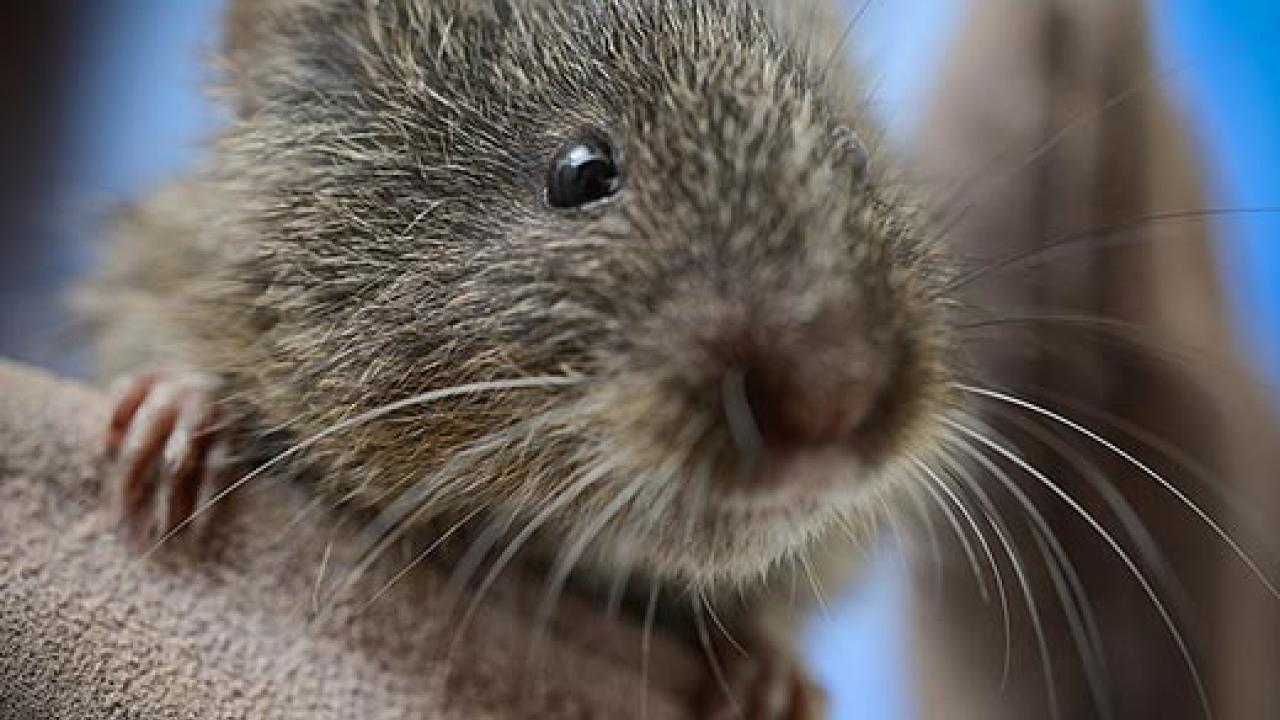Less than a year after the UC Davis School of Veterinary Medicine began a captive breeding program, more than two dozen Amargosa voles are preparing to rejoin their cousins in the wild. They are the first captive-bred group to be released and offer hope of rebuilding the population of one of the most endangered mammals in North America.
Loss of habitat, drought and climate change brought this subspecies of the California vole to near extinction, leaving only a few hundred clinging to existence in rare marshes of the Mojave Desert.
In 2014, an Amargosa vole working group acted swiftly to begin a captive breeding program to help protect them. The interdisciplinary team includes members from UC Davis, the California Department of Fish and Wildlife, the Bureau of Land Management, the U.S. Fish and Wildlife Service, the Amargosa Conservancy, U.S. Geological Survey and UC Berkeley.
“We didn’t know much about these little guys when we started—how long it would take a captive population to build, whether they’d survive, learn to eat, know how to raise pups, or their optimal breeding conditions,” said project lead Janet Foley, a professor of medicine and epidemiology at the UC Davis School of Veterinary Medicine. “We’ve learned a lot in the past few months about their population genetics, basic ecology and behavior. Fortunately, they’ve been great breeders.”
Into the wild
The captive breeding program started with 10 females and 10 males brought to UC Davis last July. During the first few weeks in captivity, the voles remained quarantined in individual enclosures. They underwent full diagnostic testing for pathogens and genetic analysis to ensure the most diverse breeding pool possible before being placed in breeding pairs.
By October, three breeding pairs produced four healthy pups. Eventually, the animals were placed outside in large escape-proof tubs planted with bulrush to mimic their native habitat. There are now an estimated 90 voles in captivity.
Before their release outside the small desert town of Tecopa, California, each vole will be tagged and outfitted with a radio transmitter so that researchers can track their movements for several months and detect survival for up to a year. The group will be split into two different marshes of high-quality habitat that has proven to be viable even during drought conditions. One of the marshes currently has a few voles; the other is not known to have an existing population.
“We plan to monitor this first release, make any changes that we need, and continue with releases to bolster the populations in the wild,” said program co-lead Deana Clifford, CDFW wildlife veterinarian and assistant clinical professor at UC Davis. “Our committed team of collaborators is also carefully monitoring the health of the marshes these voles depend on. We’re trying to restore an important, but degraded marsh so that, unlike their parents, these voles can thrive in their natural habitat.”
History of the Amargosa vole
The Amargosa vole (Microtus californicus scirpensis) inhabits sparsely located wetlands just east of Death Valley National Park. Those marsh habitats, which exist only in a few small, isolated patches throughout the desert, are increasingly threatened by drought, climate change and habitat modification by humans. The current drought has likely exacerbated their dire situation. Low water means fewer bulrushes, on which the voles depend for habitat and food.
Once thought to be extinct, the Amargosa vole was rediscovered in the late 1970s by a state fish and wildlife biologist. It was listed as an endangered species in 1980 by the state and in 1984 by the federal government. Recent research done by Foley and her husband, professor Patrick Foley at Sacramento State, indicates an 82 percent chance that the species could go extinct within five years if immediate management action is not taken.
In the past few years, the research team has worked to update information about the number of voles and where they live. Researchers have looked at additional factors impacting the Amargosa vole, including infectious diseases, competition with other rodents, predation, and other environmental pressures.
Funding for the research and captive breeding colony comes from the Bureau of Land Management, California Department of Fish and Wildlife, U.S. Fish and Wildlife Service, and the state Office of Emergency Services (drought funding). UC Davis and CDFW are donating personnel time, and Shoshone Village has been providing free field housing for the research crews.
Media Resources
Kat Kerlin, Research news (emphasis on environmental sciences), 530-750-9195, kekerlin@ucdavis.edu
Trina Wood, School of Veterinary Medicine, Communications, 530-752-5257, tjwood@ucdavis.edu
Dana Michaels, California Department of Fish and Wildlife, (916) 322-2420, Dana.Michaels@wildlife.ca.gov
